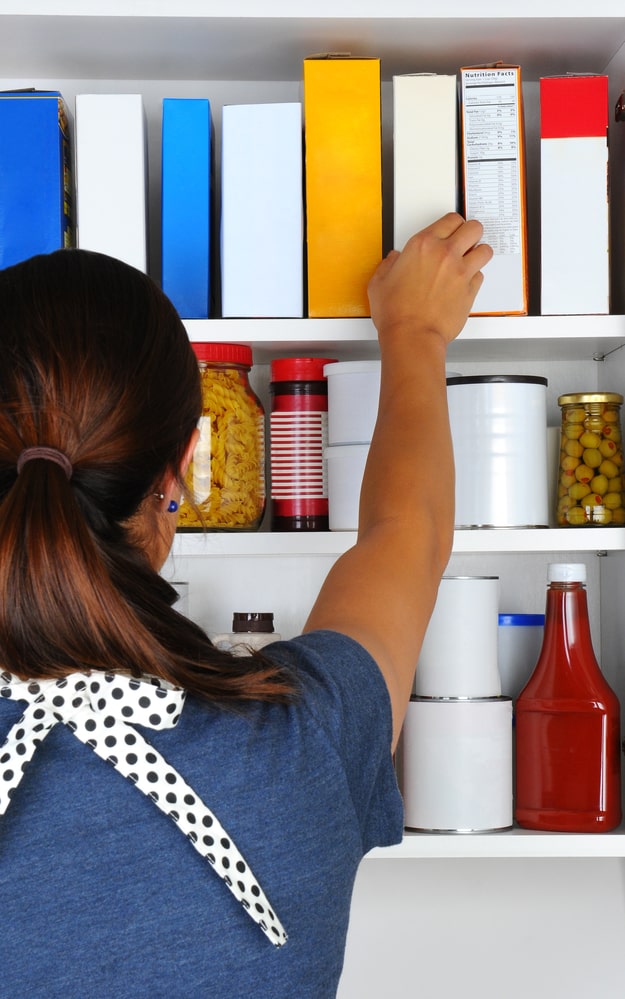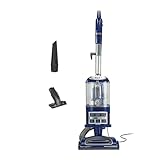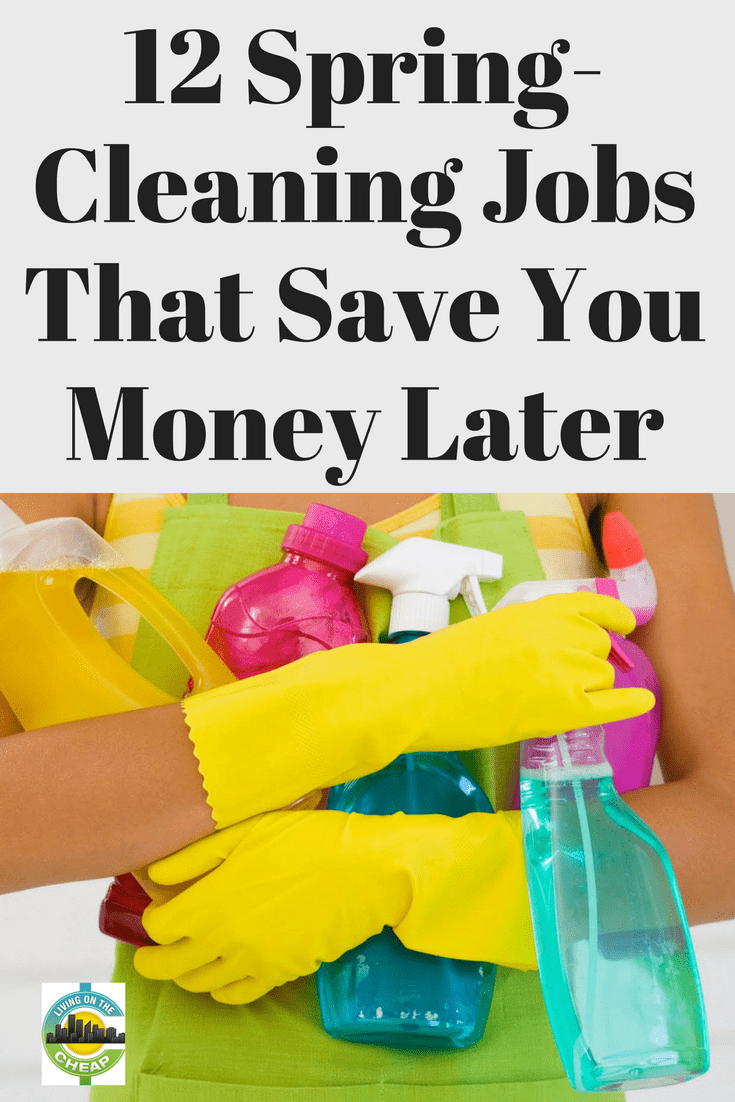Spring cleaning isn’t just a feel-good task that declutters your home and leaves it sparkling. It’s also a source of found money. Intrigued? Make your spring ritual pay off by learning how best to tackle typical spring cleaning chores and how your pursuit of cleanliness can save you a few bucks.

Photo: Deposit Photos
1. Vacuum and spot-clean sofas and chair cushions
What to do: Remove cushions and vacuum crumbs and dirt that have accumulated there. If needed, spot clean any stains on upholstery. Most stains can be cleaned using a simple solution of 1/4 cup of white distilled vinegar and 1/4 cup of water.
Spray solution on the stain or dab using a clean white cloth. Wait 5 to 15 minutes and then press with a clean cloth to remove the stain. Repeat as needed until spot is removed.
How it saves money: Regular vacuuming and spot cleaning also keeps upholstery looking new and extends the useful life of the furniture. If you’re lucky, you’ll find some loose change.
- POWERFUL SUCTION: Deep-clean carpets and tackle bare floors with multi-surface powerful suction.
- LIFT-AWAY FUNCTIONALITY: Detachable pod for cleaning under furniture or detach the nozzle to clean above the floor, on upholstery, furniture, stairs, and more.
- ANTI-ALLERGEN COMPLETE SEAL TECHNOLOGY: Works with a HEPA filter to trap dust and allergens inside the vacuum cleaner.
2. Dust ceilings, light fixtures, window shades and curtains
What to do: Vacuum or dust light fixtures and where the ceiling meets the walls to remove dust and cobwebs. Wipe slatted blinds with a mild cleaning solution (equal parts white distilled vinegar and water or 1 to 2 tablespoons liquid soap in a gallon of water). Vacuum draperies or send them out for cleaning.
How it saves money: If you have dust/mold allergies, this type of deep cleaning can improve air quality in your home, and may reduce the need for medications or trips to the doctor.
At the very least, removing dust and dirt from your environment means your furnace and A/C don’t need to work as hard, saving energy costs.
3. Shampoo or steam-clean traffic areas on carpets
What to do: Rent a carpet shampooer or steam cleaner. Vacuum thoroughly before cleaning high-traffic areas, including stairs, entryways, hallways and routine pathways within rooms.
How it saves money: Routine deep cleaning of high-traffic areas restores carpets to like-new appearance and extends their life. If you own your home, you can get a few more years of life out of your carpeting before you need to replace it.
- LIGHTWEIGHT AND COMPACT: Featuring a lightweight and compact design, the Hoover PowerDash Pet Advanced Carpet Cleaning Machine provides efficient cleaning power and easy storage. It’s an excellent choice for small homes and apartments.
- SMALL BUT MIGHTY: This upright carpet cleaner goes beyond just floors with tools and attachments that clean carpet, stairs, upholstery and more. The PowerSpin pet brush roll helps protect against pet odors.
- FASTER DRYING: Built with HeatForce technology, the PowerDash helps you enjoy clean, dry carpets in no time.
4. Change the furnace and A/C filters
What to do: For replaceable filters, check the size and head to the nearest hardware store to buy a new one. For cleanable filters, follow the manufacturer’s instructions.
If you’ve lost the user’s manual, you can usually download it from the manufacturer’s website.

Photo: Deposit Photos
How it saves money: Dirty filters make your furnace and A/C work harder to provide the same amount of heating or cooling. Changing the filters regularly reduces your electric bill.
If you have dust/mold allergies, clean filters improve the air quality in your home, and may reduce the need for medications or trips to the doctor.
5. Flip your mattress
What to do: Rotate your mattress by flipping it over in the spring, and again in fall by rotating head to foot.
How it saves money: Turning the mattress regularly distributes the wear and extends the life of the mattress.
6. Wash your pillows
What to do: Most pillows can be machine-washed. Follow the manufacturer’s recommendations.
How it saves money: Washing pillows regularly extends their useful life. If you have dust allergies or asthma, regular washing may reduce the need for medications or trips to the doctor. Wash pillows after you have dealt with a cold or other virus.
7. Vacuum condensers on refrigerators and freezers
What to do: Turn off the power at the circuit breaker or fuse box for the refrigerator or freezer. Vacuum the condenser coils, which may be located in the back or at the bottom of the cabinet behind the grill. Check the owner’s manual if you have it.
How it saves money: Removing dust from the coils optimizes the efficiency of the cooling system and ultimately reduces your electric bill.
8. Clean inside the refrigerator and freezer
What to do: Remove all contents to a cooler while you clean. If the freezer is not frost-free, you will need to wait until any ice build-up has melted. Wipe the shelves and walls using a clean sponge and one of the following cleaning solutions: 1 to 2 tablespoons baking soda in a gallon of water or equal parts white distilled vinegar and water.
Before you return bottles and jars to the refrigerator, wipe the containers with the cleaning solution. Of course discard anything old or “unknown” and organize the contents as you return them.
How it saves money: A clean and organized refrigerator and freezer makes it easy to inventory before shopping day, which can help you avoid over-buying, as well as reduce food waste.
9. Organize the pantry
What to do: Remove all contents to a table. Sort, organize and return usable items. Sell, recycle, donate or discard items you no longer use.

Photo: Deposit Photos
How it saves money: A clean and organized pantry makes it easy to inventory before shopping day, which can help you avoid overbuying, as well as reduce food waste.
10. Clear out cluttered storage areas
What to do: Go through closets and other storage areas throughout the house (bedrooms, hallways, basement, attic and garage). Set aside anything you are not using or haven’t used in over a year, including appliances, tools and supplies. If you have enough goods, hold a garage sale.
If you have a few usable goods of some value, sell them on Facebook Marketplace or eBay. (See our story on how to buy and sell online.)
Trade or resell books, DVDs and other media. Or, inventory items and simply donate to Goodwill, Salvation Army or your local Buy Nothing group.
How it saves money: Selling items you no longer use puts extra cash back in your pocket. Even donated goods can be claimed to the extent allowed on your federal income tax return, if you document the donation with a thorough inventory.
Plus, if you have fewer possessions, you won’t need to invest in storage solutions to contain all the clutter.
11. Wash patio furniture
What to do: Wash metal and plastic furniture with a solution of equal parts white distilled vinegar and water. For wood, wicker and rattan furniture, use the vinegar solution or 1-2 tablespoons of Murphy’s oil soap in a gallon of water.
How it saves money: Seasonal cleaning extends the life of outdoor furniture.
- Safely cleans wood
- Doesn't contain ammonia or bleach
- Natural and gentle cleaning power to use throughout your home
12. Scrub wood decks
What to do: Scrub wood decks with a solution of three quarts warm water, 1 quart plain household bleach (sodium hypochlorite solution) and 1/3 cup powdered laundry detergent. Caution: Do not use a detergent that contains ammonia. Ammonia and bleach react to form a poisonous gas.
Dip a deck brush into the cleaning solution and brush onto the deck. Scrub thoroughly on stained or mildewed areas. Flush with water (from a garden hose) after cleaning.
How it saves money: Thoroughly cleaning your deck each season removes dirt and any mildew, extending the life of the deck.
Make some of these spring cleaning tasks a tradition in your home and reap the benefits. You’ll not only feel better, you’ll stretch your hard-earned dollars all the way to summer.
For more cleaning tips, you might like the following articles:




